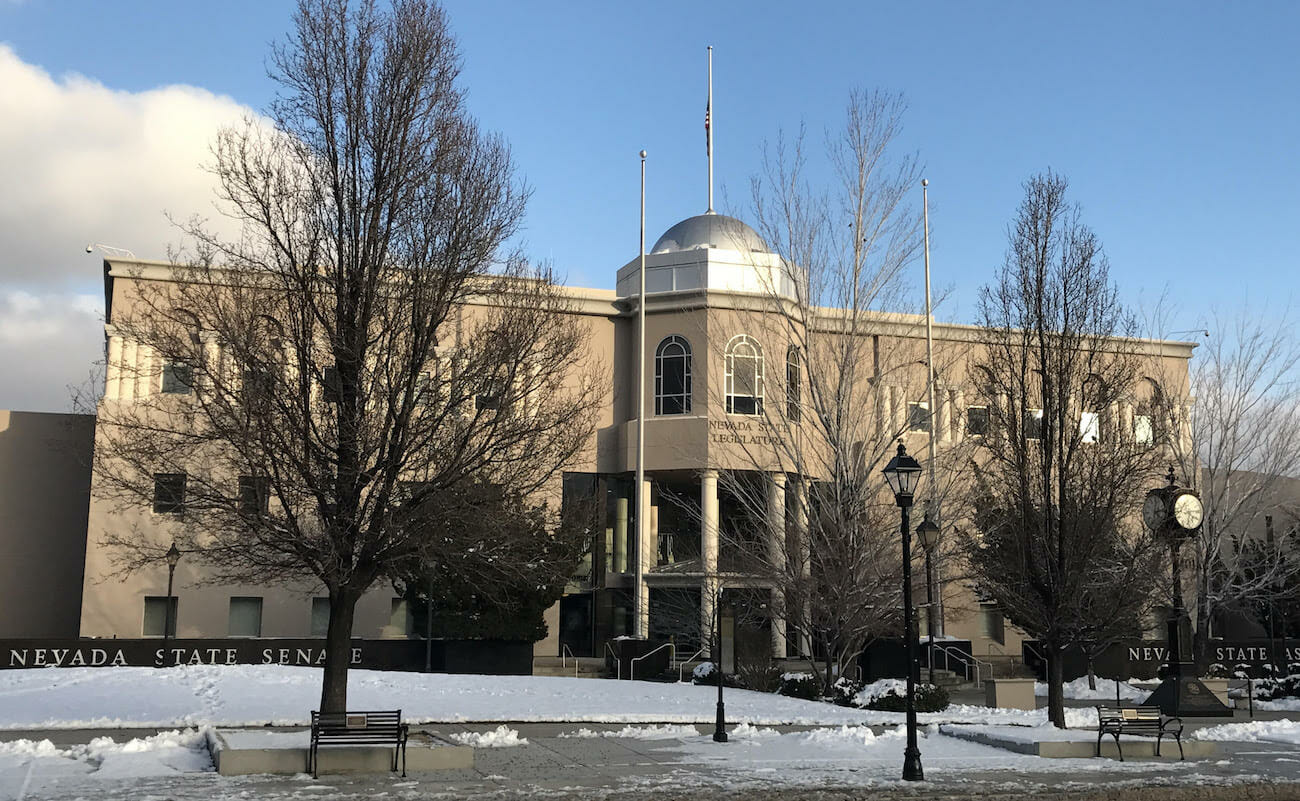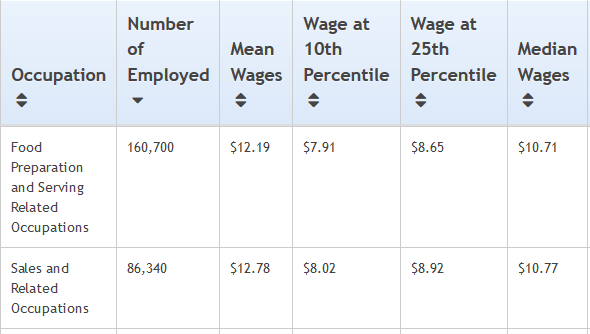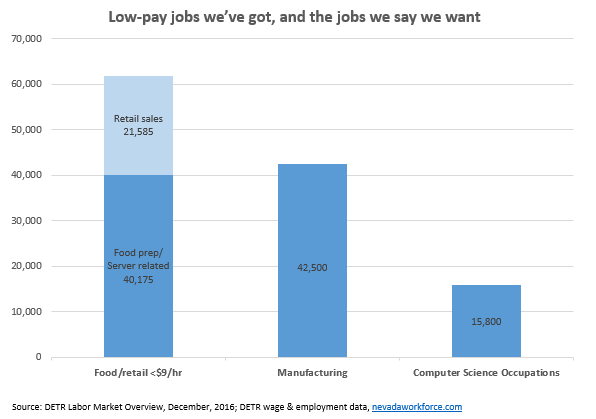No, “workforce development” is not a substitute for raising the minimum wage

Ever since the federal minimum wage was established during the Great Depression, business and business-friendly politicians have contended that it costs jobs, raises prices, and hurts small business.
Those contentions are anything but settled, especially with respect to modest wage increases, where a preponderance of economists have determined the benefits of raising the wage outweigh any harm.
They certainly are familiar arguments, though, and they were included in a statement issued by Gov. Brian Sandoval's office last week after Democrats in the state Senate introduced legislation to raise Nevada's minimum wage.
But the governor’s office offered a somewhat less familiar argument, too: "The Governor believes a better strategy to raise wages is an investment in workforce development and education programs which have proven success and also increase household prosperity.”
The connection between education and a good job was recognized by policymakers long before the term "workforce development" emerged in the 1990s.
But to assert that it is a "better strategy to raise wages" – that "workforce development" is a viable or adequate substitute for raising the minimum wage – is to assume nearly an entire Nevada workforce happily pursuing lucrative careers befitting their advanced training while few if any working adults are stuck in low-pay, low-quality jobs.
There's a problem with that.
The most common jobs in Nevada
The Democratic bill, SB106, would raise Nevada’s minimum wage from the current rate of $7.25 if employers offer health insurance and $8.25 if they don't, to $11 and $12 respectively, by 75-cent increments over five years.
A separate Assembly measure introduced Monday, AB175, would raise the wage by $1.25 a year for five years, topping out at $14 for workers with health insurance and $15 for those without.
The industry employing the most Nevadans is, by far, what state and federal agencies categorize as "Accommodation and Food Services.” At 319,000 employees in 2016, the sector accounted for one of every four jobs in the state. "Retail Trade" was a distant second with 144,000 workers. Together, the two sectors accounted for over a third of Nevada's 1.3 million workers as of the end of 2016, according to the Department of Employment, Training and Rehabilitation’s Research Analysis Bureau.
The responsibilities, quality – and pay – of jobs in those industries can vary widely. Some people, and not just (or for that matter, always) management, are paid well, especially if they’re among those who earn substantial income from tips.
But those industries also account for some of the lowest-paying jobs in the state. For instance, more than half the Nevadans employed in the Accommodation and Food Services sector, 160,000 people, work in “food preparation and serving related occupations.” In Retail Trade, the largest occupation is of course “sales and related occupations,” with 86,000 workers.
Those are the two most common jobs in Nevada – food prep/serving and retail sales.
In both, the median wage – the wage at which half the workforce makes less and half makes more – is less than $11. In both jobs, one of every four workers is paid less than $9 an hour.
The most common jobs in Nevada

Source: DETR wage and employment data nevadaworforce.com
Put another way, in those two occupations alone, there are more people who are paid less than $9 an hour than there are Nevadans (total) employed in manufacturing, one of the industries most often hyped by those who stress the importance of Nevada workforce development.
Growth in the tech sector, or as it is called in state job data – "Computer Science Applications" – is also frequently invoked when underscoring the urgent importance of workforce development. In 2016, the number of people making less than $9 an hour in either retail sales or food prep/serving was nearly four times the number of people in computer science occupations.

State projections indicate that the occupations that will grow the most – not in percentage terms, but in raw numbers – are the very same occupations that are most common now, which include not only food prep/serving and retail sales but other low-pay positions such as janitors, security guards and home health aides.
Diversification and workforce development notwithstanding, a substantial portion of Nevada's workforce will still be filling low-paying jobs, because there will be so many of those jobs to fill, for the foreseeable future.
So if we don't raise the minimum wage, then what do we do for the people who will be working in those jobs?
But ... the New Nevada
"I simply do not agree with your characterization of Nevada's workforce," said Mari St. Martin, the governor's spokesperson.
"The Bureau of Labor Statistics used to put Nevada at the top of the list for states with a majority of jobs that require no college degree," St. Martin said in an email exchange. "However, we're seeing those trends change largely due to economic diversification."
Thanks to the governor's efforts, "we will meet or exceed the goal that 60 percent of Nevadans between the ages of 25 and 34 will have earned some form of postsecondary degree or credential by 2025. This means that the lower wage jobs will be available for entry-level applicants, not household providers," St. Martin said.
The future, as envisioned in the governor's office, is a hopeful one.
But is it accurate?
“Postsecondary degree or credential” could mean an advanced degree in a scientific or technical field. It could also mean a certificate in cosmetology or heating and air conditioning maintenance and repair. In either case, a postsecondary credential does not automatically mean a good-paying job in the field; for instance, there is no shortage of research indicating that many – even most, in some studies – graduates with degrees in so-called STEM (science, technology, engineering and math) degrees are unable to find STEM jobs.
There is also no shortage of people with degrees, even advanced degrees, bussing tables or selling pants, i.e., filling Nevada's most common jobs. Similarly, a growing number of older people with degrees or training, not to mention work and life experience, are taking low-skill jobs, especially in retail, as other doors close on them.
Even landing a job in a field in which a worker has obtained postsecondary training and credentials doesn't necessarily mean a living wage. Home health aides, for instance, are often paid less than $10 an hour.
And of course the demographics of who – and who isn't – filling minimum wage or near-minimum wage jobs bears little resemblance to the old conventional assumption that it’s just teenagers. The vast majority of minimum wage workers are older than 20. More than a third of them are over 40. They're working full-time, they have children, they provide half their household’s income, and they've been stuck in the jobs in some instances for years. The myth of minimum wage jobs being filled overwhelmingly by very young entry-level workers is just that – myth.
And all that is part and parcel of an economy where, according to recent research by economist Thomas Piketty et al, “the bottom half of the income distribution in the United States has been completely shut off from economic growth since the 1970s.”
None of these realities are specific to Nevada. Rather, all of them reflect a national and even global economy that has been undergoing a series of dramatic, and traumatic, transformations. A skilled workforce is a practical and necessary precaution to provide Nevada with a chance to cope with those transformations.
The governor, per his spokesperson, believes that thanks to his workforce development agenda, "lower wage jobs will be available for entry-level applicants, not household providers,” – in which case raising the minimum wage isn’t just bad policy, but unnecessary.
It is, in a way, an optimistic vision.
It’s also one that not only fails to acknowledge the true nature of Nevada’s real economy, but blithely ignores the destructive economic forces that have been relentlessly hammering working and middle class Nevadans for the last 40 years.
It's not an either/or
“I don’t see the two policies, raising the minimum wage and more investment in workforce development, as mutually exclusive, but mutually reinforcing,” said Jeff Waddoups, chair of the Department of Economics in the Lee Business School at UNLV.
Waddoups was one of more than 600 economists nationwide who signed a letter in 2014 calling on the President and Congress to raise the federal minimum wage to $10.10 by 2016. (Under SB106, it would be three years before the Nevada minimum wage topped $10 for workers without health insurance, four years for insured workers.)
“If the fear is that raising the minimum wage will reduce employment and thereby reduce opportunities for low-skill workers, it is unfounded – the evidence simply doesn’t support it,” Waddoups said. “The evidence does suggest, however, that if firms have to pay a little more for their workers, they will make efforts to keep them around longer and perhaps make them more productive, which means that firms will have more of an incentive to invest in training and development with a higher minimum wage.”
UNR Economics Professor and Associate Dean Elliott Parker (a member of The NV Indy Outlook team) also signed that 2014 letter. “Nevada definitely needs to fund and promote workforce development and education,” Parker said, adding that successful workforce development programs will mean that fewer workers will need a higher minimum wage. But workforce development and education “is not a substitute for increasing the minimum wage to at least keep up with past price inflation.”
“It’s not an either/or,” Parker said.
Magnificent obsession
In 2015 Sandoval and the Legislature enacted a long-overdue tax on Nevada businesses, largely based on the argument that a better-educated workforce is a prerequisite for a more diversified and stable economy. That argument, by the way, is correct.
But education and training, like legislation to fund vouchers for private schools, transfer public schools with low-income students to private charter operators, or force a local school district to reorganize itself, can also be high-profile attention soaks. To hear the governor and influential policymakers tell it, why, there is nothing wrong with Nevada that education can’t fix.
So allow me to reiterate a point I’ve made on multiple occasions in the past: If we could snap our fingers and magically ensure every working age Nevadan had an advanced degree in a STEM field tomorrow, one-fourth of the workforce, at the very least, would still be working in low-paying, low-quality jobs with little or no benefits, little or no stability, and little opportunity for advancement. Because those are, in large part, the jobs we’ve got. They will also be, in large part, the jobs we’ll have in the future. We need them to be filled, and finding that many teenagers may be a tall order.
Yes, low pay is not just a Nevada problem. But while Nevada can’t fix the plight of all working Americans, it is within the state’s power to improve wages (and for that matter, conditions) for the hundreds of thousands of Nevadans who could really, really use a raise.
Educating and training young Nevadans for better jobs is a grand idea. Full speed ahead.
But workforce development is not a substitute for raising the minimum wage. And it shouldn’t be a distraction from the very real need to do so.
Feature photo by David Calvert.
